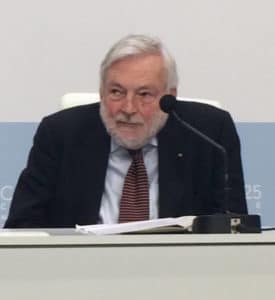“The Removal of CO2 is our only real hope for the climate”
by Peter Wadhams
(Solution or band aid? The capture of CO2, to which the “Green & Blue” section of La Repubblica, a daily Italian newspaper, has just dedicated a special edition as well as the cover of the paper edition, divides experts, scientists and environmentalists between those who consider it an essential tool to return carbon dioxide in the atmosphere to pre-industrial levels and those who think that investing money in these techniques will only delay the transition to renewable energy with zero emissions.)
There are two reasons why some environmental organizations oppose efforts to reduce the concentration of CO2 in the atmosphere, or to adopt measures that manage solar radiation by increasing the ability to reflect some of it back into space (so-called “geoengineering”). The first reason has some potential justification; the second has none.
The reasoned objection to geoengineering techniques is that the measures taken can have unforeseen climatic consequences, so that instead of improving the climate situation we could make it worse. This objection was mainly applied to the release of dust aerosols into the stratosphere, so that the tiny particles scatter incoming solar radiation and reflect it back into space. The real problem is that, once released, the aerosol spreads around the planet and remains in the atmosphere for months before settling on the ground due to gravity or rain. During its stay in the air the aerosol could have an unexpected impact on climatic processes, and even if we became aware of undesirable effects we could not do anything about it until the aerosol dispersed.

But there are other techniques that get around this problem and that allow you to manage the impact of solar radiation on the climate in an immediate and controllable way. A case in point is Marine Cloud Brightening (MCB), a technique invented by British engineers John Latham and Stephen Salter, in which finely divided sprays of seawater are injected through nozzles into low-lying clouds. The immediate effect is to increase the ability of clouds to reflect sunlight back into space. Therefore, if unforeseen climatic consequences occur, it is enough to stop the seawater intake to no longer cause damage. This would make MCB an important and harmless measure to reduce warming. It does not affect CO2 levels, but it reflects some of the energy arriving on Earth, thus offering only a buffer remedy for global warming.
Then there are the unreasonable objections of some environmentalists to the removal of CO2. I admit that I can’t understand their logic. They claim that if we could remove CO2 from the atmosphere, we would give selfish people an excuse not to change their lifestyle so that they emit less CO2.
Greenpeace, in particular, opposes the development of Carbon Capture and Storage (CCS) as a technique for CO2 reduction . To some extent they confuse this technique with a quite different procedure, Direct Air Capture (DAC), in which carbon dioxide is chemically removed from clean air and pumped underground to sequester it or transform into useful material, such as artificial limestone or jet fuel. Most scientists recognize that DAC and its development are vital to the survival of the planet, because it actually reduces CO2 levels and thus returns the climate to preindustrial conditions.
But it is understandable that Greenpeace attacks CCS, which has proven to be more expensive than previously thought. CCS is expensive and technically difficult to apply to chimney emissions from factories and power plants. In reality, the funds for its development were not colossal, but certainly the money spent on CCS could have been much better invested in the development and application of DAC, our only real hope for a bearable future climate.
Today we emit 42 GT (Gigatonnes, or billions of tons) of CO2 per year from the use of fossil fuels, so if we want to lower the CO2 levels in the atmosphere to preindustrial levels, we have to remove 42 GT just to remain at the current level, and then many more GT to gradually bring our atmosphere to a lower CO2 level. If we could spontaneously reduce our emissions, say to 20 GT per year, it would mean that we would “only” have to remove 20 GT from the atmosphere by carbon capture techniques, and any further removal would have a net positive effect in breaking down CO2 that we have accumulated in the atmosphere over the last few centuries. This would also have a global economic benefit.
To reduce the greenhouse effect, the advent of an effective CO2 removal system is essential. Reducing our current carbon emissions, which Greenpeace praises as the best solution to the greenhouse effect, is actually not a solution in itself. Since CO2 has a lifespan of hundreds or thousands of years in the atmosphere, every molecule we release remains in the environment and continues to heat the Earth. Reducing emissions can only slow global warming, not reverse it, a point Greenpeace seems to miss.
Finally, to assume that humans will exploit geoengineering success to drive larger cars or undertake other unlimited uses of fossil fuels is to take a very negative view of human nature. I prefer to believe that the advent of large-scale direct air capture will inspire people to help the process by minimizing their emissions.
(Peter Wadhams directed the Scott Polar Research Institute in Cambridge from 1987 to 1992 and was a Professor of Ocean Physics and head of the Polar Oceans Physics Group in the Department of Applied Mathematics and Theoretical Physics (DAMTP) of the University of Cambridge from 1992 to 2015. He is the author of Farewell to Ice, published by Bollati Boringhieri.)

Dr. Peter Wadhams, Emeritus Professor, Ocean Physics, Head of the Polar Ocean Physics Group, University of Cambridge, with 40 years of research in sea ice and ocean processes in the Arctic and the Antarctic and author of numerous publications on the dynamics and thermodynamics of sea ice, sea ice thickness, waves in ice, icebergs, and ocean convection.